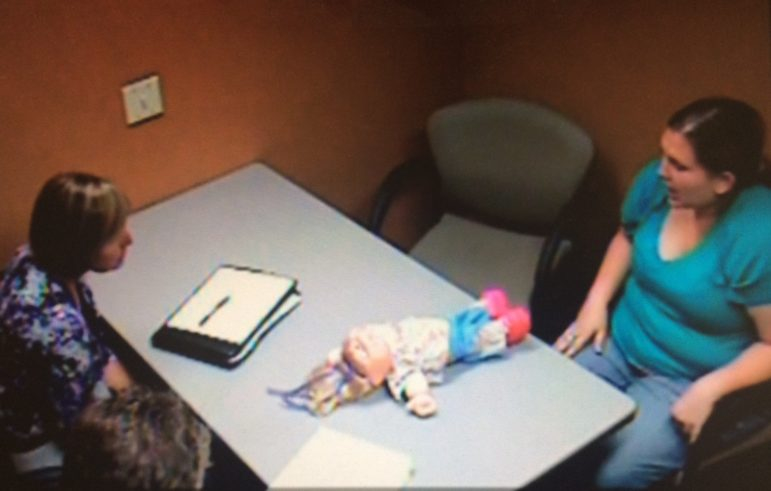Interrogation Technique Causes False Confessions?
High pressure Reid Technique — used to wrongly convict Brendan Dassey — can trap the innocent.

Manitowoc County Sheriff’s Department Sgt. Joy Brixius escorts Brendan Dassey from the Manitowoc County Jail to the Manitowoc County Courthouse, April 19, 2007, in Manitowoc, Wisconsin. Dassey, 17, was charged with first-degree intentional homicide, mutilating a corpse and first-degree sexual assault in the death of 25-year-old Teresa Halbach on Oct. 31, 2005. In 2016 a Milwaukee judge overturned the conviction, finding that the shifting stories of the crime the young man gave during interrogation were mostly fed to him by the police. Photo by Dan Powers of the USA TODAY NETWORK-Wisconsin.
As she voluntarily entered the police interrogation room in Moline, Illinois, four years ago, Dorothy Varallo-Speckeen thought she was there to help solve a child-abuse case.
She soon realized, however, Detective Marcella O’Brien thought she — a then-22-year-old babysitter with no criminal record — had abused the child, a felony punishable by up to 30 years imprisonment.
In the videotaped interrogation, O’Brien said, “I’m not trying to point fingers, but I know for a fact that the injury occurred during the time when you guys were watching Brylee,” referring to Varallo-Speckeen and her girlfriend and the 15-month-old toddler they were watching.
O’Brien subjected Varallo-Speckeen to an interrogation that sought to extract a confession.
Her tactics are common in law enforcement, but some experts say they can coerce false confessions and should be abandoned.
Last year, the conviction of Brendan Dassey, the Wisconsin teenager charged with helping his uncle murder a young woman in 2005, was overturned after a federal judge found his confession had been coerced. In June, the 7th Circuit U.S. Court of Appeals upheld that decision. The case is featured in the 2015 Netflix series, Making a Murderer.

Dorothy Varallo-Speckeen holds up her mug shot from July 2013, after being charged with felony aggravated battery against a child, punishable by up to 30 years. Varallo-Speckeen pleaded guilty to, and served time for, misdemeanor battery causing bodily harm but says she felt coerced into admitting to a crime she says she didn’t commit. Photo by Krista Johnson of IowaWatch.
Some of the tactics used in interrogating Dassey were at play when O’Brien grilled Varallo-Speckeen about the baby’s injury.
During that interrogation O’Brien talked over Varallo-Speckeen, interrupted and rejected or cut off denials and repeatedly pushed O’Brien’s theory — that Varallo-Speckeen had broken the legs of the young girl.
Maybe she was too rough changing a diaper, or maybe she accidentally hurt the child, O’Brien suggested time and again. Despite Varallo-Speckeen’s insistence that she wasn’t too rough, that she did not hurt the toddler, that she had not changed the baby’s diaper during the hours in question, O’Brien held to the theory that Varallo-Speckeen was to blame.
After nearly two hours in the interrogation room and after O’Brien once more insisted that Varallo-Speckeen must have caused the injuries, Varallo-Speckeen relented. It happened when Varallo-Speckeen recalled the moment her girlfriend first said the child’s legs were broken.
Varallo-Speckeen: And so then she was like well, her legs are broke, and then I was confused like how, how did that happen? That was my reaction.
Varallo-Speckeen: I think it was because I was changing her diaper.
Looking back on that day, July 24, 2013, Varallo-Speckeen now 26, said she believes O’Brien coerced that confession.
The detective and Moline police officials declined several requests for interviews over several months about the case and interrogation practices.
O’Brien’s tactics mirrored the Reid Technique of Interviewing and Interrogation, which researchers describe as the gold standard for interrogating suspects. A majority of law enforcement officials are being trained to use it or another method based on it.
Critics note that more than one-fourth of wrongfully convicted suspects later exonerated with DNA evidence had given a false confession or incriminating statement, according to the Innocence Project, a nonprofit that works to exonerate the wrongly convicted.
Some critics point to a technique used in the United Kingdom as an effective and fair alternative. Known as PEACE, the approach focuses more on gathering information than eliciting confessions.
Andy Griffiths, a retired United Kingdom detective superintendent, said his country no longer sees cases going to the UK’s appeals court because of false confessions.
But Joseph Buckley, president of John E. Reid and Associates, stands by the technique, saying it is an ethical and efficient way to obtain justice, and he denies false confessions and the Reid Technique are related. He said the Reid Technique’s core principles are aimed at preventing false confessions. Buckley said, for example, that interrogators are instructed to get corroborating details in the suspect’s written statement.
To understand police interrogation techniques, IowaWatch interviewed experts, read police records of the case, analyzed the video and transcript of Varrallo-Speckeen’s interrogation and compared it to Reid methods.
Statements heard in the interrogation video indicate that two others and possibly a third were alone with the child during the time in which she was injured.
The incident
Two months before the incident, Varallo-Speckeen and her girlfriend, Jennifer Schafer, 30, moved into a basement apartment in the home of Schafer’s friend, Jami Kepple. Kepple’s mother, Kim Linhart, and cousin, Brad Hessell, lived in the apartment upstairs.
At 5 a.m. on July 22, Kepple took her daughters to the apartment of her mother, Linhart, before leaving for work. Normally Linhart watched her grandchildren, but Hessell, the cousin, said he watched the girls because Linhart was ill.

Nearly four years since her arrest in July 2013 for felony aggravated battery against a child, Dorothy Varallo-Speckeen stands outside her East Moline home that she shares with her girlfriend Jennifer Schafer. Photo by Krista Johnson of IowaWatch.
Around 7:30 a.m., Hessell took the girls downstairs for Varallo-Speckeen and Schafer to watch while he went to work. Hessell told Schafer that Brylee was not feeling well and to give her Tylenol. She slept until 11 a.m., when Schafer changed her diaper.
“When I picked her up to change her diaper, she was real fussy,” Schafer told IowaWatch. “Like every time you moved her, like when I picked up her legs to slide the diaper in and out, she just kind of screamed a little at me; I thought maybe her belly hurt, thought maybe when I pulled her legs up it squished on her belly.”
Later, Schafer took Jasmine, Kepple’s eldest daughter, outside to play, while Brylee and Varallo-Speckeen napped on the couch. When Schafer returned about 45 minutes later, Varallo-Speckeen was awake, but Brylee was still sleeping on Varallo-Speckeen’s chest.
When Kepple returned from work at 1:30, she drove Brylee to Illini Hospital in Silvis, Illinois.
“There was clearly something wrong, but nobody knew what,” Schafer said. “She just wasn’t acting herself.”
Schafer told O’Brien that Kepple said the hospital found nothing seriously wrong with Brylee. The next day, July 23, both of Brylee’s legs were swollen, and Kepple took her to Trinity East Hospital in Moline, where staff discovered the child’s legs were broken.
Police were called, and Detective O’Brien soon focused on Varallo-Speckeen.
The interview
When the Reid Technique was introduced in 1974, it was meant to replace interrogation tactics that involved threats, beatings and even torture. The creator of the technique was a former Chicago detective, John E. Reid, and he had elicited his first confession using it in 1955.
Whether O’Brien had received Reid training could not be determined, because she refused repeated interview requests. However, her tactics followed the technique.
Starting with a “behavioral analysis interview,” investigators are taught to ask non-threatening questions to understand the individual’s demeanor, then decide whether he or she is lying based on verbal and nonverbal cues.

Steve Drizin, legal director of the Center on Wrongful Convictions of Youth, represented Brendan Dassey in his appeal against his murder conviction. A federal judge in Milwaukee last year overturned Dassey’s conviction, finding the then-16-year-old was coerced into confessing. The Wisconsin Department of Justice is fighting Dassey’s release. Photo courtesy of Steve Drizin.
But Reid’s opponents say it is impossible to detect deception accurately.
“You simply cannot tell whether a person is lying or telling the truth based on those cues,” said Stephanie Madon, an Iowa State University psychology professor who researches why people confess to crimes they did not commit.
The Reid Technique tells interrogators there is not any one cue or response that can determine deception, and that all behavioral cues need to be analyzed.
“But in the course of a high pressure investigation, these are snap judgments being made by detectives, and they’re often wrong,” said Steve Drizin, legal director of the Center on Wrongful Convictions of Youth, who represented Dassey in his appeal.
Some trained in the technique say the behavioral analysis interview causes tunnel vision.
“You’ve already decided a person is guilty, so now you’re looking for confirmation,” said James Trainum, author of How the Police Generate False Confessions and a former Washington, D.C., homicide detective.
Trainum said he realized this after eliciting the confession of a woman he was sure was guilty in 1994. When evidence proved she could not have committed the murder to which she had admitted, he began to wonder what had gone wrong.
“The truth you are trying to get is the truth you believe in,” Trainum said. Reid, he said, focuses too much on confessions and not enough on gathering information.
Said Drizin: “That confession is the most powerful piece of evidence in the court of law, and it ends up corrupting the quest for truth.”

Brendan Dassey appears at the Manitowoc County Courthouse in Manitowoc, Wisconsin, April 16, 2007. In 2016, Dassey’s conviction was overturned after a federal judge found his confession had been coerced. Photo by Dan Powers of the USA TODAY NETWORK-Wisconsin.
In the case of Drizin’s client, Dassey, a federal judge in Milwaukee last year overturned his conviction, finding the then-16-year-old was coerced into confessing to helping his uncle, Steven Avery, murder Teresa Halbach at the Avery family salvage yard in Two Rivers, Wisconsin in 2005.
In June, the federal appeals court in Chicago upheld that decision, but the Wisconsin Department of Justice is fighting Dassey’s release. Dassey’s defense team argued, and the appeals court agreed, that the shifting stories of the crime the young man gave during interrogation were mostly fed to him by the police.
“The confession became a story crafted by the investigators instead of by Dassey,” the judges found.
Avery’s case also is under appeal. Both have maintained they are innocent.
Madison attorney Dean Strang, who represented Steven Avery at trial, said two of the Reid tactics used on Dassey were particularly troublesome. One was the “aggressive, repeated use of the ‘false friend,’ ” in which interrogators pretended they were helping Dassey avoid trouble, Strang said. The other was “repeatedly referring to false evidence” of Dassey’s guilt.
Those tactics, Strang said, are especially risky when applied to “people who are young or sharply limited in their mental capacity — and Brendan was both.”
“There’s just no question that the sustained use of those strategies produced not only an involuntary confession, but false one,” he said.
The interrogation
In the interrogation stage, investigators can move through nine steps, starting with accusing the suspect of the crime or of knowing something about it.
“So obviously something happened in your care,” O’Brien told Varallo-Speckeen. “Now, do I think it was on purpose? Absolutely not. I don’t think that you guys, or most people are the type of person who intentionally hurt a baby. I think that type of thing would be an evil person who would do that — I mean if you’re going to hurt a baby, you would have to be a very mean, evil person and plan that. I don’t think that was the case. I think what happened was an accident.”

Dorothy Varallo-Speckeen is seen during a police interrogation in Moline, Illinois, on July 24, 2013. Looking back on that day, Varallo-Speckeen said she believes O’Brien coerced that confession. Screen shot from Moline, Illinois, police interview video.
Thirty-six times during the interrogation, O’Brien told Varallo-Speckeen she was guilty or knew what happened to Brylee.
The second step of Reid teaches investigators to develop a theme giving the suspect justification or excuses for committing the crime. Investigators deflect denials by talking over and using gestures to cut the suspect off.
Either way, Drizin said, “innocence is off the table.”
O’Brien presented Varallo-Speckeen with a variety of accidental ways the injuries could have occurred. It was O’Brien’s suggestion that it could have happened during a diaper change, although Schafer and Varallo-Speckeen both told O’Brien that Varallo-Speckeen had not changed Brylee’s diaper on July 22.
When Varallo-Speckeen said she didn’t remember doing anything that could have hurt Brylee, O’Brien cut her off. In the two-hour interrogation, split between Schafer and Varallo-Speckeen, O’Brien interrupted her 71 times.
Reid methodology teaches investigators to share stories about others who have made similar mistakes, a tactic that either minimizes or maximizes the severity of the crime. O’Brien told Varallo-Speckeen about past cases where children had fractured skulls and bleeding on the brain.
“On a scale of things, this is not that severe,” O’Brien said. “Bones heal. Bruises go away. It’s not going to be something that’s going to be a horrible impact for the rest of their life.”
O’Brien told her repeatedly that Varallo-Speckeen was the only person who had been alone with Brylee, although statements given to O’Brien by Hessell, Schafer and Varallo-Speckeen and viewed by IowaWatch show that is not true. Presenting false evidence is another Reid tactic, made legal by the U.S. Supreme Court case Frazier v. Cupp.
Interrogation scholars have pushed to change this law, and in other countries it is illegal to lie to a suspect about evidence.
The confession
As the interrogation continued, O’Brien repeatedly insisted that Varallo-Speckeen must have broken Brylee’s legs while changing her diaper.
At one point, O’Brien handed her a baby doll, instructing her to demonstrate how she changed diapers. O’Brien watched as Varallo-Speckeen put a diaper on the doll. But O’Brien didn’t accept her demonstration.
“That wouldn’t be enough force,” O’Brien said.
“Well, that’s how I change diapers,” Varallo-Speckeen responded.
Nevertheless, the detective continued pressing her theory, and Varallo-Speckeen began to waiver. If O’Brien believed Varallo-Speckeen was guilty, that must be what happened, she told O’Brien, adding she was willing to take the consequences.
Still, the detective was not satisfied. Why would Varallo-Speckeen take responsibility for something she didn’t do? O’Brien asked her.
“I just want it over,” Varallo-Speckeen told O’Brien.

Dorothy Varallo-Speckeen looks at the transcript from her July 2013 interrogation by a Moline, Illinois, police detective about a toddler Varallo-Speckeen babysat who suffered two broken legs. After nearly two hours of being interrogated, Varallo-Speckeen admitted to the crime, which she later said she didn’t commit, claiming the confession had been coerced. Photo by Krista Johnson of IowaWatch.
In an IowaWatch interview, Varallo-Speckeen said: “I feel like I admitted to a story that I was told. I feel like I just agreed to get it off the table, to just get it out of there, to just get it done.”
Varallo-Speckeen was charged with felony aggravated battery against a child. Two years later, she accepted a plea bargain, pleading guilty to misdemeanor battery causing bodily harm.She said she pleaded guilty to avoid going to prison “for something I know I didn’t do.”
The month she spent in jail in 2013 was counted toward her sentence, and she remained under court supervision for 12 months. Media coverage of the case ruined her reputation, ending her babysitting work and costing her lots of friends, Varallo-Speckeen said.
Following the charges, Brylee’s mother, Kepple, told Schafer in a Facebook message that she did not know who hurt her daughter, that she didn’t trust the police and that she just wanted Brylee to be okay. Kepple declined to talk to the press then, and she declined to comment on this story.
The debate
Reid critics say other interrogation methods would prevent false confessions and that police need more training in interviewing and interrogating. But Reid’s proponents do not believe the techniques cause false confessions, nor that other options would help close cases.
Wicklander-Zulawski and Associates, an Illinois consulting firm that has trained thousands of law enforcement officials nationwide, stopped offering Reid training in 2017.
Shane Sturman, chief executive officer, said Wicklander-Zulawski officials listened to academics, police interrogation researchers and law enforcement officials and decided the non-confrontational methods they have offered since 1983 work just as well.
“It’s not the Reid method that’s the problem as much as the misuse of the Reid Technique,” Sturman said.
Buckley said if a false confession occurs, it is not a matter of misusing the Reid Technique but rather not using it at all.
Reid methods say interrogators should treat subjects with respect, not make promises of leniency, threaten physical harm or inevitable consequences, deny their rights or the opportunity to satisfy physical needs.
Regardless of what causes false confessions, many agree something needs to be done to prevent imprisonment of innocent people.
“We need to have a major change in the culture in law enforcement, unfortunately,” Trainum said. “Our problem is we are so focused on closing cases and locking up criminals, we kind of lost our perspective that our real goal is to gather information that is admissible and reliable and unbiased. Let the evidence take us where it may.”
This story was produced by the Iowa Center for Public Affairs Journalism-IowaWatch.org, a nonprofit, online news website that collaborates with Iowa news organizations to produce explanatory and investigative reporting. The nonprofit Wisconsin Center for Investigative Journalism (www.WisconsinWatch.org) added Wisconsin-focused content to this version and distributed it to additional news organizations. WCIJ collaborates with Wisconsin Public Radio, Wisconsin Public Television, other news media and the UW-Madison School of Journalism and Mass Communication. All works created, published, posted or disseminated by the Center do not necessarily reflect the views or opinions of UW-Madison or any of its affiliates.
Cruel and Unusual
-
Jail Fees Can Leave Inmates in Debt
 Oct 4th, 2019 by Izabela Zaluska
Oct 4th, 2019 by Izabela Zaluska
-
Rules Violations Cause 40% of Prison Admissions
 Jul 3rd, 2019 by Izabela Zaluska
Jul 3rd, 2019 by Izabela Zaluska
-
Evers Faces Hurdles to Cutting Prisons
 Jul 1st, 2019 by Izabela Zaluska
Jul 1st, 2019 by Izabela Zaluska






















we need to keep publishing this ,daily, everywhere.